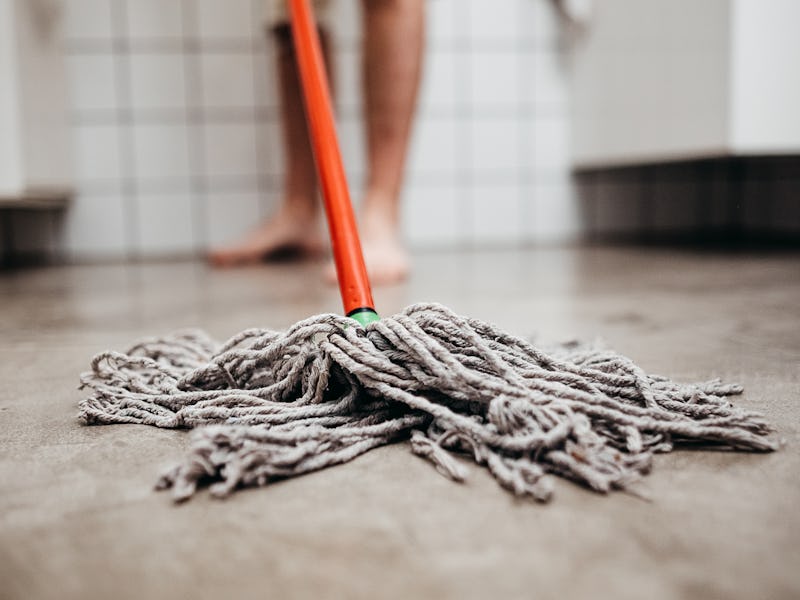Study: Mopping with this household cleaner is like breathing car exhaust
Once released, volatile organic compounds strike the body twice.

In March of 2020, as alarming facts about Covid-19 piled onto an already anxiety-withered public, lab studies found that the virus lingers on surfaces. Bus seats, shopping carts, and door handles suddenly seemed ominous.
By the summer, scientists had concluded the novel virus loses its ability to infect soon after it’s expelled from the body; inanimate objects posed little risk. But the world had already adapted to the cleaning craze. In a 2021 survey, people had increased their frequency of cleaning by about 70 percent and the amount of cleaning product they used by 74 percent.
Amid this sanitization fever, a study published last month in Science Advances serves as a reminder that cleaning products aren’t innocuous. In fact, they can create indoor air pollution. A lot, apparently.
What’s new — In the study, mopping with monoterpene-based cleaning products — which are ubiquitous in the U.S. — created as many airborne particles in a closed-off room as one would take in standing in an urban downtown during rush hour.
LONGEVITY HACKS is a regular series from Inverse on the science-backed strategies to live better, healthier, and longer without medicine. Get more in our Hacks index.
“We found that the amount of particles that were produced during each mopping period was either equivalent or more than what you would be inhaling when you're standing on a busy road where thousands of vehicles pass by every day and have your huge buildings around,” lead author Colleen Rosales, an atmospheric and air pollution chemist at Indiana University, tells Inverse.
Fortunately, there are simple ways to protect yourself during this pine-scented toxin eruption.
Background — In most environments, particle pollution happens in two stages. First there is the initial release of particles, through a combustion or the release of chemicals. Then there is the oxidation of the volatile organic compounds, or VOCs, released.
VOCs are a class of compounds that quickly evaporate into the air and are easily inhaled. They occur naturally and are also emitted in many common household products — including paint, paint strippers, glue, varnishes, pesticides, cosmetics, deodorants, and cleaning solutions.
After VOCs are distributed in the air, they come into contact with an oxidant in the home, usually ozone., and are distributed again, usually more thickly than the first time.
According to the Environmental Protection Agency, VOCs can irritate the eyes, nose, and throat; cause headaches, loss of coordination, and nausea; and damage the liver, kidneys, and central nervous system.
“It's kind of hard to avoid because there's so many cleaners out there that are scented and they clean well.”
Monoterpenes are a class of VOCs commonly used in cleaning supplies, as well as perfumes and products marked “essential oils,” because of their pleasing scent.
“Anything that is citrus-scented or pine-scented will have monoterpenes in them,” says Rosales, and it is difficult to find floor and surface cleaners in the U.S. without them.
Science in Action — In the study, one researcher mopped the floor and wiped surfaces of a mechanically ventilated test room, using a commercial monoterpene-based household cleaner, a kind available at most grocery stores.
The researchers used a mass spectrometer to trace the particles in the room — including VOCs and monoterpenes. They took measurements after the initial mopping and continued during the secondary reaction from oxidation.
Someone in the room would breathe in particles, at a rate of 560 million to more than a billion per minute, says Rosales. In total, this is comparable to being on a highway shoulder, getting bathed in car exhaust.
As they peaked in abundance during oxidation (the second exposure), monoterpenes reached 380 parts per billion which, the paper says, was “190 times more than the peak outdoor monoterpene mixing ratios observed outside the research building for this day.” In other words, that’s the exposure to monoterpenes someone would experience in a natural environment.
Simply wearing a mask while cleaning will save you from some of the effects of volatile organic compounds.
What It’s a Hack — There are some easy ways to avoid the low-level chemical assault of a monoterpene-based cleaning, according to Rosales.
- Wear a mask over your nose and mouth. We’re all familiar with them now.
- Use a fan with a filtration system. This will not only absorb the initial dousing of monoterpenes but also the ozone with which they oxidize to stay in the atmosphere of your home.
- Install a filtration system in your place, if you can afford it.
- Search for a cleaner that doesn’t use monoterpenes. They may not be marked but are probably the ones without any scent. “It's kind of hard to avoid because there's so many cleaners out there that are scented and they clean well,” she says.
- Clean in the morning or evening. Ozone tends to be highest in the afternoon.
How This Affects Longevity — Scientists are just beginning to understand the ill effects of our constant exposure to small chemical irritants. The oxidation of monoterpenes, in particular, has been observed to cause oxidative stress on human cells in lab environments, negatively affecting cellular proliferation and cell viability.
Simply being mindful that chemical cleaners are not harmless may be just enough to take us out of the pandemic-driven hygiene theater era. More might not always be better when it comes to cleaners and sanitizers.
Hack Score — Four out of ten troubling particles swept away 🧹🧹🧹🧹